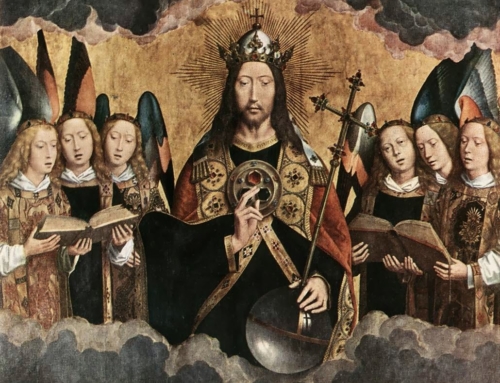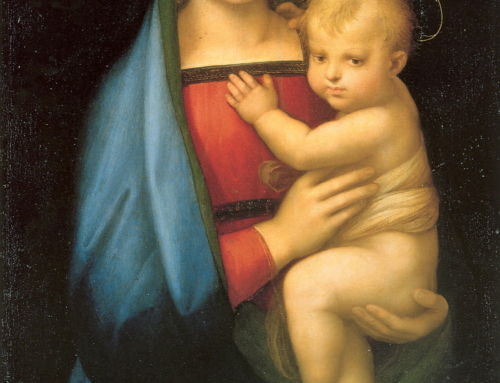In the summer of 1987 I had three months free, and decided to make a hitch-hiking pilgrimage to Jerusalem. I had visited Benedictine monasteries in England and decided to stay in monasteries and convents all along the route. It was a glorious summer and I had an excellent adventure. One of the best parts of the trip was visiting Benedictine houses all across France and Italy. I stayed at famous places like Mont St Michel, Solemses and Fleury where the relics of St Benedict are preserved. I visited Subiaco and Monte Cassino where St Benedict lived and worked. I also stopped at more out of the way monasteries. They were high in the Alps, on an island at Venice and in the centre of Rome.
At each monastery I was given a warm welcome in the true Benedictine tradition of hospitality. As I stayed with the monks I got first hand experience of their way of life. It is a simple, balanced and dignified life style. Many people regard monks as extremists, but I learned to see things in a different way. Here was a group of men who decided to live together to pursue a life of prayer, study and work. They weren’t the ones who were insane. Instead their quiet sanity made the usual race for money and power seem crazy.
A few years ago my friend Rod Dreher wrote an important book, The Benedict Option which highlights the life of St Benedict and his relevance today. St Benedict is the father of Western monasticism, but he is also named as the patron of Europe. Benedict is patron of Europe because the monasteries that kept his simple rule helped to preserve the ancient learning and culture of Greek and Rome after the Roman Empire crumbled. Benedict’s disciples founded monasteries that became centres of culture and learning throughout the Middle Ages. The monasteries became centres of learning, health care, justice and the arts. Benedict’s rule also established a primitive form of democracy in an age of tyranny. The rule also established the foundation for modern human rights because in the community each person was treated with respect and honour. Benedict’s monasteries valued learning, good manners, discipline and self respect. The monks taught that these ordinary virtues were part of the call to holiness. Benedict reminds us that all of these virtues—including holiness– are vital for a civilisation of decency, order and peaceful prosperity.
Benedict lived in the sixth century when the Roman Empire was falling into ruins. The values he established were vital then. They are just as necessary now. Our own society is suffering from the same symptoms of decay as ancient Rome. Lawlessness, immorality, greed and despair are all around us. Benedict’s principles for a good and balanced life are enshrined in the three vows which Benedictine monks and nuns make. They take vows of stability, obedience and conversion of life. From these three promises come the balance which we need as individuals and as a society.
Stability means being rooted. The Benedictine monk or nun promises to stay committed to his or her monastic community for life. We need this kind of commitment in our marriages, in our parishes and in our communities. These days it seems that very few people are willing to persevere. When things get rough people bail out. Commitment seems to be a dirty word. Stability means getting stuck in and not giving up on a particular community or commitment. Stability means we find God and happiness right where we are, and that we don’t have to flit about after every trend, fashion or new idea.
Obedience is a harsh word in a society where anything goes and pleasure seems to be the only guiding principle. But the root of the word ‘obey’ means ‘to listen’. True obedience means listening to others and responding to their needs. The obedient person is always alert to the spoken and unspoken needs of those around them. Obedience builds peace and understanding in communities. Obedience is vital for the Catholic life to prosper. We need to listen to God, listen to the Scriptures, listen to the Church and listen to the Holy Spirit within us. Then after listening comes action.
Conversion of Life is the dynamic vow. The person who seeks conversion of life is always looking for a new way to see life. This principle does not just mean being converted in the religious sense. It is a way of looking at life that is creative, optimistic and positive. It sees possibilities, not problems. It gives people the benefit of the doubt. It is always seeking to convert the difficulties of life into opportunities for growth. The person who vows to follow conversion of life wants to convert the whole world from death and despair to new life and hope.
These three principles are not just for monks and nuns. They can be applied to our families, our businesses, our schools, parishes and local communities. The Benedictine Rule was written in the sixth century, but it is timeless in its appeal. It is always relevant because Benedict understood people. He understood what makes us tick, and that will never change. Writers on the Benedictine way have showed how Benedictine principles apply to life for lay people. A recent book, written by a team from Ampleforth Abbey shows how Benedictine principles can be applied to business management. I have tried to show how Benedict’s rule applies to the task of being a modern parent. Others have shown how Benedict’s rule helps illuminate politics and school life.
In the 1950s, the writer T.S. Eliot thought that Europe would have to go through a new Dark Age in the future. He also thought that the monasteries would preserve the best of the ancient culture and pass it on to the future. I think Eliot had the right idea, but did not see that the wisdom of Benedict might also help to save the culture through a wider dissemination through the church and society. The Benedict Option is something that can be lived out within our homes and parishes too. This is one of the reasons during Advent this year I’m doing a four week study on St Benedict for our parish and hoping to lead our parish and school to be more consciously Benedictine in our approach to community.
You can also learn more about St Benedict in the six week video course available here on the blog-website. You can either purchase it as a stand alone item in the bookstore or have access to it in the video section of the blog when you become a Donor Subscriber at the Promotion Level or above.
Each one of us can help in the process of building Benedictine balance. We can study Rod’s book and learn how the Benedictine balance can be woven into our families, our parishes, our schools and our world. We can also support our local Benedictine monastery with prayer. We can visit the monastery or convent and support the monks and nuns with our friendship. If we are in positions of leadership we can learn more about the Benedictine way, and let Benedict’s timeless wisdom direct our path.







I very much enjoyed the course. I too had a rather austere viewpoint of the monks. …glad to be mistaken. Would love to go on a retreat with them and experience their balanced world. 🙂